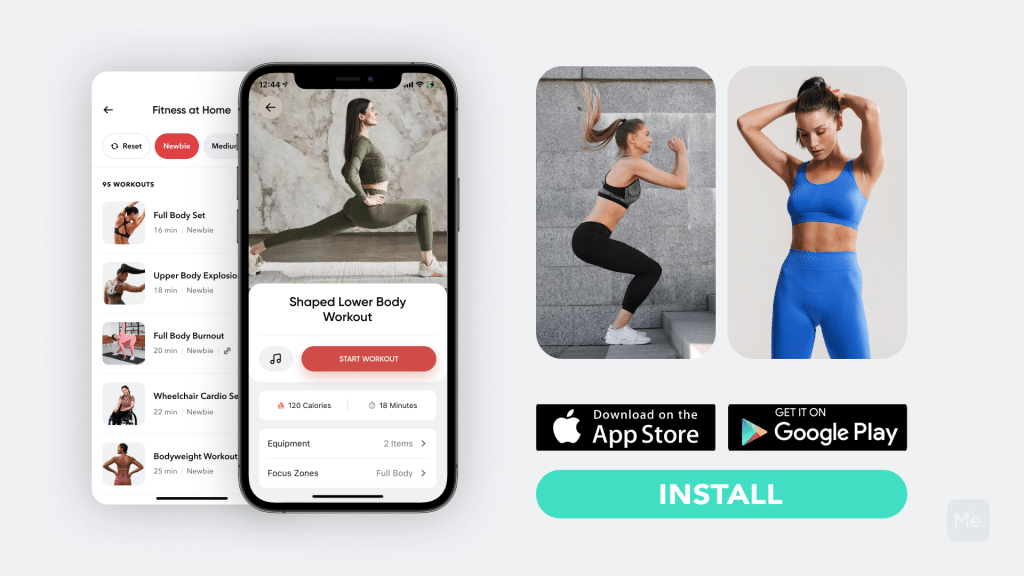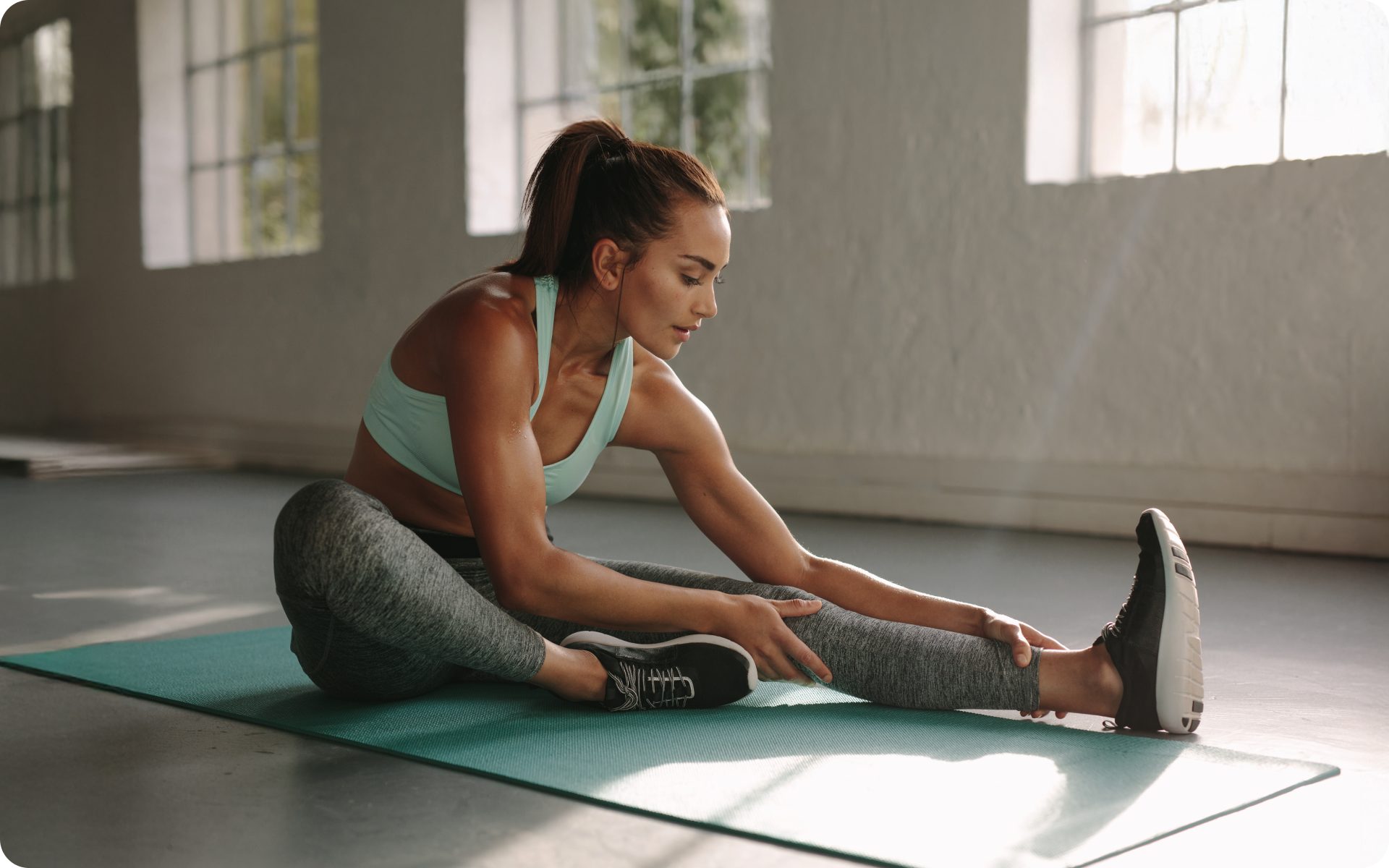Squats have always been an integral move for all gym goers. Whether you have just started training or are a pro athlete, you can’t omit squats from your workout regime. The traditional back squat has always been a go-to movement to enhance lower body strength. Spice things up a little, like a goblet squat, and you can work towards increased strength and injury prevention (1). Knowing the difference between a goblet and a back squat will help you to make informed decisions. Both appear to have the same pattern, but some key differences make them stand apart. This article dives deep into the debate of goblet squat vs. back squat, coupled with some instant tips on using this movement to power your exercise. Let’s jump in!
What Is A Goblet Squat?
A goblet squat is performed by holding a dumbbell or a kettlebell in front of the chest. This is one of the main differences when differentiating between a goblet squat vs. a normal squat. It is called so because it appears like you are holding a goblet as you move up and down. It works more muscles because you hold weight and increases the work done by the glutes and quadriceps (2).
- Start by taking a kettlebell and supporting it with both hands, holding it at chest level while cradling the bottom of the bell.
- Next, stand with your feet spread apart at shoulder-width, keep your chest out, engage your lat muscles, and look straight ahead.
- Before initiating the squat movement, take a deep breath and fill your abdominal area with air while simultaneously bracing your core.
- To begin, initiate the movement by pushing your hips backward. Bend your hips and knees, ensuring that your chest stays upright and your knees are forced out until your thighs parallel the floor.
- Finally, push your feet into the ground, driving yourself back up to the initial position.
- Repeat the same movement for the designated number of reps.
Slow-to-moderate tempos and performing higher reps with the goblet squat is best to build muscles. One advantage of the goblet squat is safety. There is a low risk of dropping the weight on the floor, even if one’s technique begins to break down.
Read More: Master The Goblet Squats: Muscles Worked, Variations, And Quick Tips
What Is A Back Squat?
There is no strength training exercise like a back squat. It hits many lower body and core muscles to improve performance (3). This workout can improve sports performance or be added to the rehabilitation process to strengthen the joints.
Here is how you can perform a back squat:
- Start by putting the bar on your shoulders from a rack to do a barbell back squat. Stand with your feet about shoulder-width apart. Hold the bar with a firm grip outside of your shoulders.
- Point your elbows down and back, brace your core, and bend forward from your hips. Keep your core tight as you lower your body, but don’t round your back.
- Keep your upper body straight and tall as you bring your hips down and back. Continue until your hips are lower than your knees, and try to keep your knees in line with your toes. Keep your heels in contact with the ground throughout the exercise.
- To finish, stand back up. You’ve done one repetition when fully extending your hips and knees.
Breathing is essential for a back squat and is important throughout the exercise. Besides this, you should ensure adequate rest between the sets and not choose weights too heavy.
How Many Goblet Squats Should I Do?
Some movements ask for a precise regime to bring better outcomes. A goblet squat, however, is quite versatile. You can change the rep scheme and set it to use this workout differently.
- Beginners can do between 3 to 10 reps while focusing on their techniques
- Those trying to build muscles should do at least 4 sets of 8-12 reps with relatively heavier weights
- When using this as a technique tool, do 4-5 sets of 5 reps with a slow tempo
- Aim for 15 to 20 reps per set and perform 3 to 4 sets if the goal is to improve cardio fitness and muscular strength
Remember, it’s crucial to maintain proper form throughout the exercise to prevent injury. If you’re new to goblet squats or any exercise, consider working with a qualified fitness professional to ensure you perform them correctly and safely.
Intense sweat sessions, working weight loss tips, lip-smacking recipes come in one package with the BetterMe app. And all of it is at your fingertips, start transforming your life now!
How Many Goblet Squats A Day?
Developing and sustaining flexibility, strength, and coordination can be challenging, but maintaining these qualities becomes significantly easier once achieved. By incorporating goblet squats into your daily routine, you can retain the ability to perform squats effectively even as you age. The best part is that it’s a simple practice! All you need to do is complete a set of goblet squats daily.
It is important to note that goblet squats serve as a strength-building exercise and a means to enhance movement quality. In this context, we focus on improving movement quality. It is recommended to use an appropriate weight to achieve this goal. Generally, women can opt for weights ranging from 10 to 30 pounds, while men can consider weights between 20 and 50 pounds, depending on their abilities.
Goblet squat standards can help you to compare one-rep max lift with other lifters at your body weight. And although the right amount of weight depends on your fitness goals, most trainers suggest starting light. For example, begin with 5 pounds and add weights per your tolerance.
Don’t forget to evaluate goblet squat standards vs. back squats to understand what works in your favor. Muscle growth primarily occurs when training volume, time under tension, and loading increase. Lifting weights at around 50-75% of your best squat for 12-16 sets per week, with rep ranges of 6-12, can contribute to muscle growth.
Heavy goblet squats may be suitable for weaker athletes or beginners to stimulate muscle growth. They may not provide enough training stimulus for most experienced lifters.
Are Goblet Squats As Good As Back Squats?
The two clear differences between a goblet and a back squat are:
- Location of the weight relative to the center of the mass
- The equipment used for each workout
Goblet squat requires a kettlebell or dumbbell, and the mass stays in front of the chest. Meanwhile, the back squat requires using a barbell with the option of adding more weights as the bar rests on your shoulders.
The goblet squat and back squat both work similar muscles, but they emphasize slightly different areas. Goblet squats mainly target the quadriceps (front of the thighs), while back squats emphasize the glutes (buttocks) more.
Let’s have a glance at the goblet squat vs. back squat muscles worked:
Muscles Worked In A Goblet Squat
The goblet squat primarily targets and works several key muscles, including the glutes (buttocks), quadriceps (front of the thighs), abductors (outer thighs), adductors (inner thighs), and erector spinae (muscles along the spine) (4).
Check out the list of primary muscle groups in more detail:
- Quadriceps: In the eccentric (down) and concentric (up) portions of the squat, the prime muscle predominantly utilized is the quadriceps. Goblet squats place a greater emphasis on the quadriceps, resulting in a heightened focus on this muscle group during both the downward and upward phases of the exercise.
- Glutes: Bottom of the squat
- Erector Spinae: Maintaining an upright posture becomes essential while holding the weight when performing goblet squats.
- Abductors & Adductors: Balance/stability
Read More: Squat, Throw, Catch: The Wall Ball Workout Guide You Need To Gain Muscle And Lose Fat
Muscles Worked In A Back Squat
The primary muscles worked in a back squat are:
- Quadriceps: The main muscle utilized during both the eccentric (downward) and concentric (upward) phases of the squat is the quadriceps femoris, commonly referred to as the quadriceps.
- Glutes: At the bottom position of the squat, particularly in back squats, there is an increased emphasis on the gluteus maximus, which is the primary muscle targeted in this phase.
- Erector Spinae: Maintaining an upright posture while holding the weight is essential to engage and stabilize the core muscles, particularly the erector spinae and the abdominal muscles.
- Abductors & Adductors: Enhancing hip stability and overall balance. These muscles help maintain proper alignment and control during movements, contributing to a stable base of support for the body.
Goblet squats can replace the back squat for daily fitness. Individuals learning to squat can also use this routine to improve their strength and resistance. As for the athletes training to build strength within a specific sport, back squats are considered a better choice for strength training.
A goblet squat needs more upper body strength because you must hold a dumbbell. The weight is located further near your center of mass. Comparing a goblet squat vs. a barbell squat, we cannot state that one is better. They are both simple variations of a squat. What you choose depends on your goals and training needs.
Are Goblet Squats Harder Than Back Squats?
Goblet squats present a greater difficulty than back squats due to the weight being loaded on your chest and stabilized by your arms. As your arms are not as strong as your entire back, the weight you can lift during goblet squats is considerably lower.
Goblet squats involve holding a single dumbbell vertically at your chest, using your arms for support. They are frequently used as a warm-up exercise and an accessory movement because they allow individuals to achieve a deeper squat while primarily targeting the quadriceps without engaging the back as much.
Comparable to dumbbell squats, the amount of weight you can handle in goblet squats is limited by your ability to support it with your arms and chest. However, the goblet positioning typically allows for better stabilization of a slightly heavier weight compared to having a dumbbell in each arm.
The main differences between a goblet squat vs. back squat are:
- It is easy to squat deep down in a goblet squat
- You can lift a higher weight in the barbell squat
Goblet Squat – Pros And Cons
The goblet squat is a squat variation that emphasizes the quadriceps more than back squats. Instead of having the weight on the upper back, you hold the weight in front of your body in a goblet squat. This means the glutes are not as involved as the main muscles used are the quadriceps.
Performing a goblet squat requires more upper back and biceps strength to stabilize the weight in front of your body. Additionally, it places a greater workload on the abdominal muscles at the front of your core because of where the weight is positioned, relative to your center of mass.
These factors show that the goblet squat has additional requirements and leg strength. Whether this is advantageous or not depends on your specific training goals.
Whether you’re looking to simply pep up your fitness routine, jazz up your diet with mouth-watering low-calorie recipes or want to get your act together and significantly drop that number on your scale – BetterMe app has got you covered! Improve your body and revamp your life with us!
Back Squat – Pros And Cons
The back squat allows for heavier weight than the goblet squat because the barbell rests on the upper back, minimizing the impact on the upper back and bicep strength. This makes it an effective exercise for strength training.
Note that performing the back squat with incorrect technique, especially when using a significant amount of weight, can be dangerous. Proper form and technique should be prioritized to ensure safety and reduce the risk of injury during the exercise.
The Bottom Line
We can now establish that a back squat is far superior for strengthening, muscle mass, and great forms of fitness. But someone with mobility issues can opt for a goblet squat. To optimize your squatting technique, consider adopting the following approach: acquire proficiency in the goblet squat, enhance your mobility, and gradually transition to utilizing a barbell during your squats.
Instead of being caught up in the debates about a goblet squat vs. a back squat, it is essential to determine what works in your favor. Knowing your fitness goals, you can design a workout plan accordingly.
DISCLAIMER:
This article is intended for general informational purposes only and does not serve to address individual circumstances. It is not a substitute for professional advice or help and should not be relied on for making any kind of decision-making. Any action taken as a direct or indirect result of the information in this article is entirely at your own risk and is your sole responsibility.
BetterMe, its content staff, and its medical advisors accept no responsibility for inaccuracies, errors, misstatements, inconsistencies, or omissions and specifically disclaim any liability, loss or risk, personal, professional or otherwise, which may be incurred as a consequence, directly or indirectly, of the use and/or application of any content.
You should always seek the advice of your physician or other qualified health provider with any questions you may have regarding a medical condition or your specific situation. Never disregard professional medical advice or delay seeking it because of BetterMe content. If you suspect or think you may have a medical emergency, call your doctor.
SOURCES:
- The Front Squat vs. the Back Squat (2021, kaiafit.com)
- How to Do a Goblet Squat (2022, verywellfit.com)
- The back squat: A proposed assessment of functional deficits and technical factors that limit performance (2015, ncbi.nlm.nih.gov)
- THE MUSCLES USED IN SQUATS – SQUAT BIOMECHANICS EXPLAINED (n.d., blog.nasm.org)











